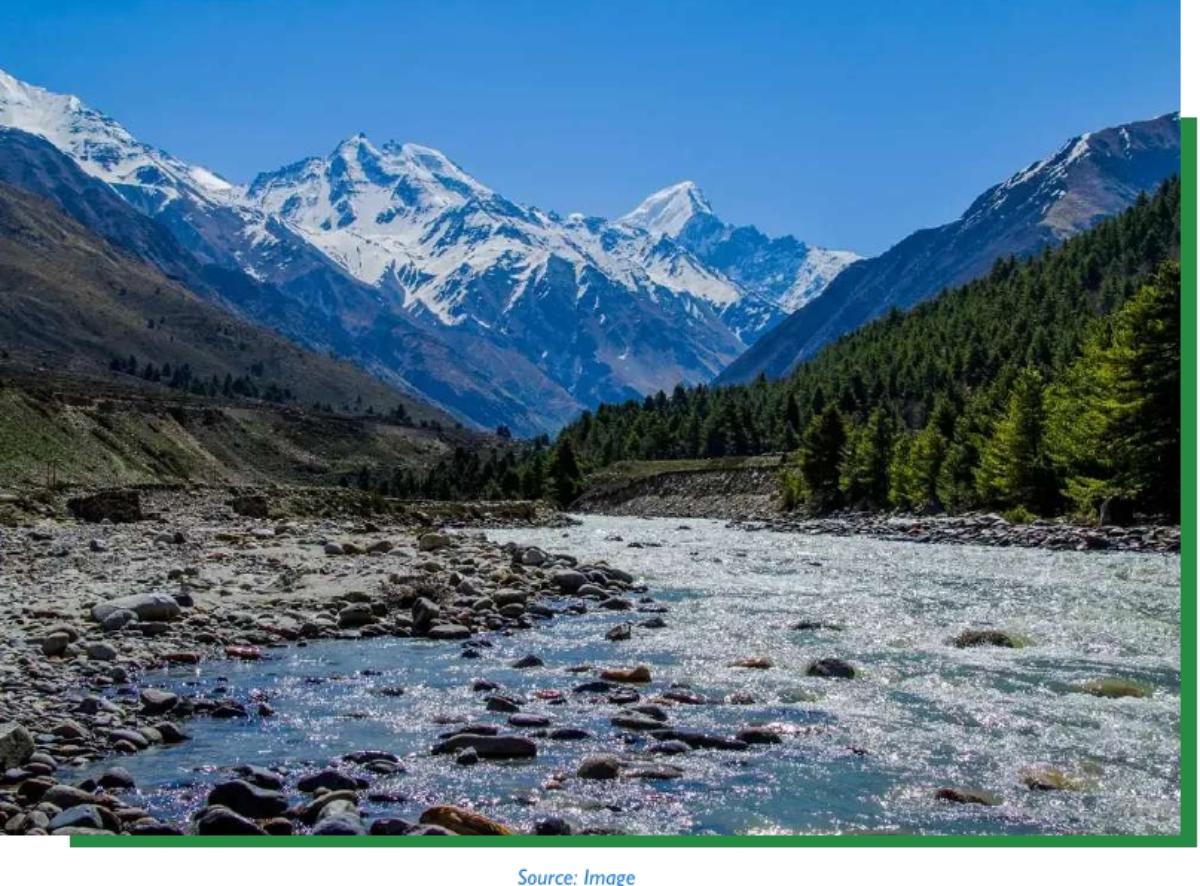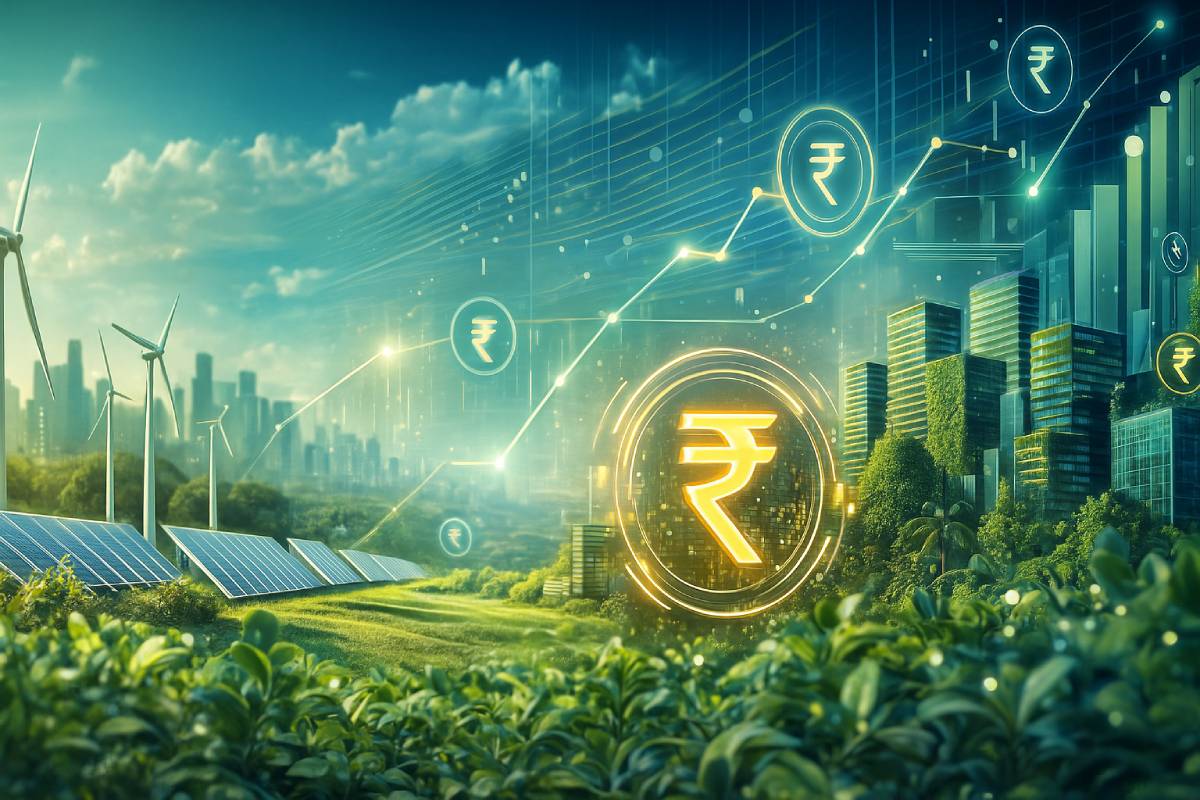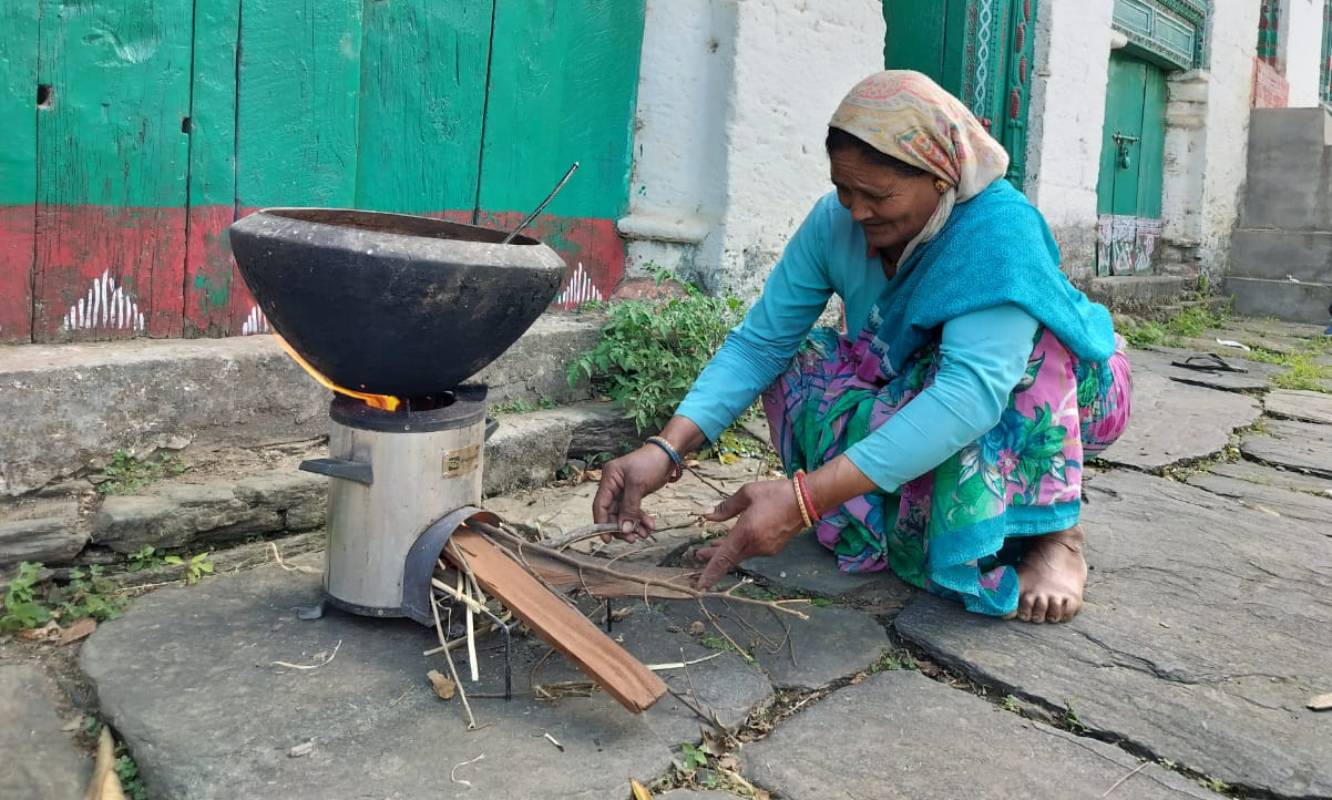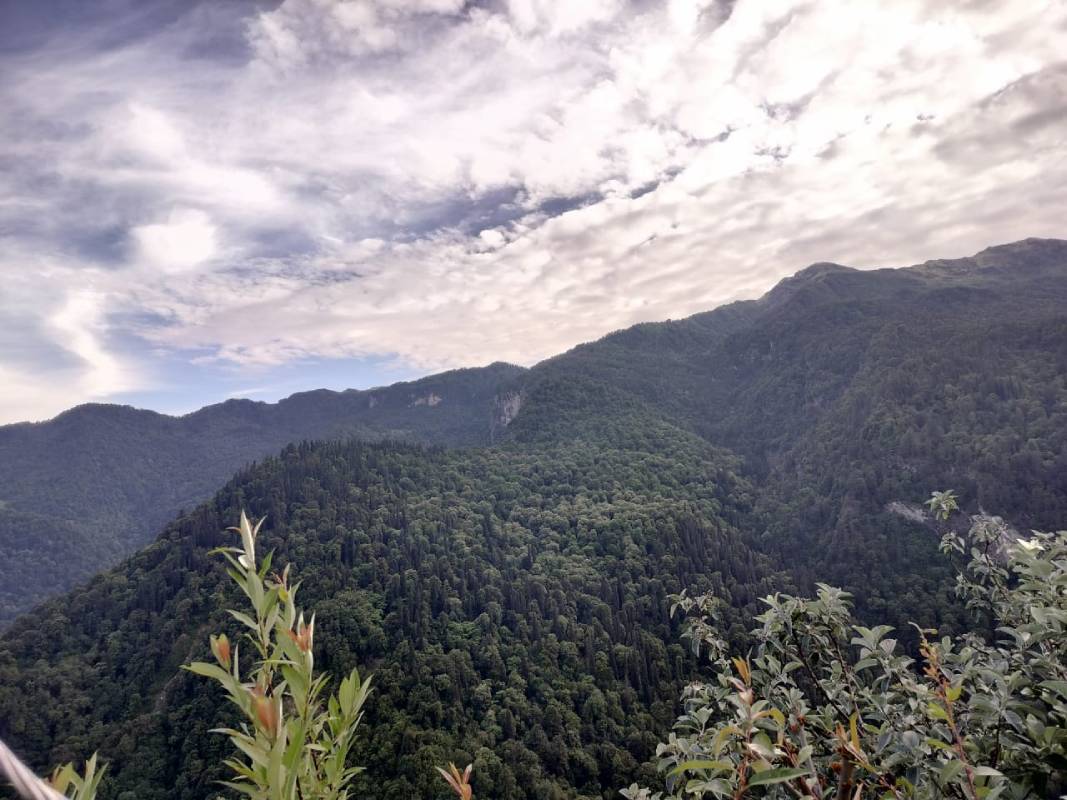State of Water Resources in Himachal Pradesh
Himachal Pradesh is endowed with five major river networks namely Sutluj, Beas, Ravi, Chenab and Yamuna. Sutluj has the largest catchment in the state followed by Baes and Chenab. 90% of river catchment in the state is part of the Indus river basin. However, the Yamuna River which shares nearly 10% of the total catchment in the state is part of Ganga river basin[1]. This complex network of rivers and their tributaries is a significant source of water in the state.
The state also has a huge deposit of snow in the form of glaciers and permanent snowfields. The seven major river catchments of the state have 800 glaciers spread in 3,124 sq km area. Moreover, 2,679 permanent snowfields spread in a 1,775 sq km area feed these river basins. The Chenab river basin has the highest number of glaciers (457) and Satluj River has the highest number of permanent snowfields (857)[2]. This huge snow deposit in the higher altitudes of the state feeds a number of perennial rivers and hundreds of springs in the state.
Major Water Statistics of Himachal Pradesh
| Number of major river catchments | Number | 04 |
| No of Glaciers | Number | 800 |
| Number of Permanent snowfields | Number | 2,679 |
| Number of Surface water sources | Number | 20,223 |
| Number of Traditional water sources | Number | 10,512 |
| Number of villages with springs | Number | 2,597 |
| Ground water recharge worth area | Sq. Km. | 3,468 |
| Annual Groundwater recharge | BCM | 1.11 |
| Number of groundwater sources | Number | 8,186 |
Source: Compiled from various government sources
Perennial spring, lakes and other traditional water sources also contribute significantly in providing water to local communities for various usages. According to a survey conducted in 1991-93, there are 33,350 water sources meeting water demands in Rural Himachal Pradesh. The survey has also enumerated 8,186 ground water sources in the state[3]. More than half of these water resources (20,223) are surface water sources. Yet another study commissioned by NITI Aayog in 2017 found that 2,597 villages of the state have springs[4]. The first ever census of water bodies released in 2023 by the Ministry of Jal Shakti has revealed that Himachal Pradesh has 88,017 different kinds of water bodies such as ponds, tanks, lakes, reservoirs etc[5].
Census of Water Bodies- Himachal Pradesh
| Type of Water Body | Number |
| Pond | 3,247 |
| Tanks | 56,583 |
| Lakes | 106 |
| Reservoirs | 249 |
| Water Conservation structures | 893 |
| Other | 26,939 |
| Total | 88,017 |
Source: Water Body Census, 2023
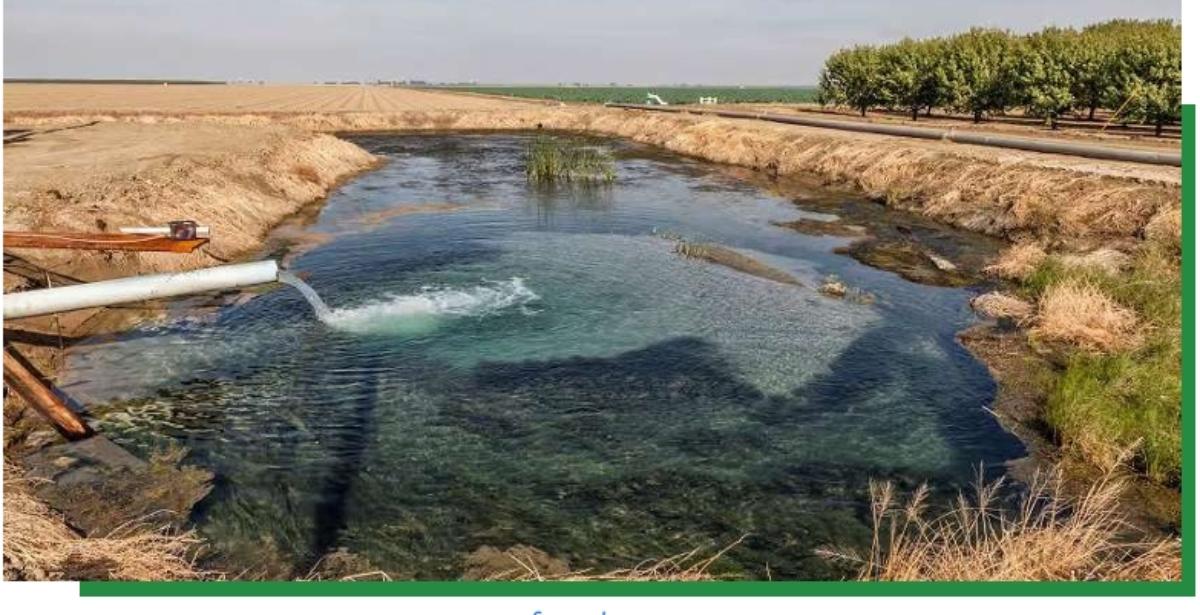
Groundwater is important to meet water demand in valleys and lower altitudes. According to the assessment of the Central Ground Water board, Himachal Pradesh recharges 1.11 BCM per year and it has potential to extract 1.01 BCM groundwater per year. The report further observed that all its monitored areas are in the safe category and the cumulative water draft of the state is 34.95%. Groundwater is used majorly in districts like Kangra, Sirmour, Mandi, Solan and Una. In total 0.35 BCM groundwater was extracted in the last assessment year for irrigation, industrial and domestic usages. Irrigation is the highest consumer of groundwater (0.18 BCM) followed by domestic use (0.12BCM) and Industrial (0.05 BCM)[6].
Water Challenges
Himachal Pradesh seems to have high availability of water from a variety of sources ranging from ground water to glaciers. However, various studies have found that all types of water sources are facing challenges leading to shortage of water, drying of landscape and extreme weather conditions such as drought and flooding. Moreover, the demand for water has grown exponentially in the last couple of decades. The Human Development Report of the State published in 2002 estimated that the total water requirement of the state will increase from 454.5 Million Litre per Day (MLD) in 1999 to 726 MLD in 2021[7]. The Energy and Resource Institute (TERI) in an estimate projected that the water demand of the state will go up to 1,000 MLD in 2030[8]. On the one hand water sources are facing existential crisis, on the other hand water demand is increasing exponentially in the state. Major supply side challenges faced by the state are as follows:
Receding of Glaciers:
A study conducted by scientists of IIT Hamirpur in 2022 found that glacial area in Himachal Pradesh is decreasing at the rate of 67.84 sq km per annum. The study calculated that the total glacial area has decreased from 4,020 sq km in 1994 to 2,198 sq km in 2021[9].
Drying up of Water Sources:
Drying up of water sources such as ponds, tanks and spring is a serious issue in the state. A report of NITI Aayog published in 2017 observed that nearly 60% of springs have dried in the Indian Himalayan Region. The Census of Water Bodies released by the Ministry of Jal Shakti in 2023 observed that 12,146 out of 88,017 water bodies are not in use in the state. Of these nearly 8,000 water bodies are not in use because either they are dried or destroyed.
Pressure on Underground Aquifers:
While the ground water is not a very significant source of water right now, dependency on it is expected to increase in future due to shortage of surface water. The latest report of CGWB reveals that nearly half of wells monitored by it observe a decrease in water level.
Degradation of River Catchments:
With continuous deterioration of quality of forest, landslides and flooding the catchment areas of various rivers have degraded. Moreover, river pollution has also increased in recent times. According to a report of the Central Pollution Control Board, nine rivers of the state namely Ashini, Khad, Bald, Giri, Markanda, Pabbar, Ratta, Shikari Khad, Sirsa and Sukhana are critically polluted with respect to BOD criteria[10].
State of Forests in Himachal Pradesh
Forests in Himachal Pradesh have been the backbone of local subsistence and a significant source of state revenue. It is highly diverse which ranges from dry scrub forests at lower altitude to alpine pasture at higher altitude. The Forest Survey of India has recorded 38 different forest types in this small Himalayan State. As the altitude increases the density of forest cover also increases in the state up to 3000 meter. More than 58 percent of dense forest of the state is located between 2000 to 3000 meter and more than 60% of open forest is located between altitudes of 500 to 2000 meter. According to statistics of Himachal Pradesh government Himalayan Moist Temperate forest is largest forest category in the state, which includes tree species such as Cedrus Deodara, Quercus leucotrichophora, Quercus dilatata, Quercus semecarpifolia, Rhododendron arboretum, Pinus wallichiana, Abies Pindrowand Piceasmithiana[11]. Details of forest types in the state are given in the following table.
| Forest Type as per ISFR 2021 | Area (sq km) |
| Tropical Moist Deciduous | 208.63 |
| Northern Tropical Dry Mixed Deciduous | 2,848.42 |
| Subtropical Pine | 2,841.11 |
| Himalayan Moist Temperate | 7,079.16 |
| Himalayan Dry Temperate | 502.51 |
| Sub Alpine Forests | 661.47 |
| Moist Alpine Scrub | 58.05 |
| Dry Alpine Scrub | 335.7 |
| Grasslands | |
| Himalayan Temperate Pastures | 1,004.58 |
| Alpine Pasture | 3,271.73 |
The Himalayan Moist Temperate forests are also known as oak forest which has high importance to support local subsistence along with alpine pasture land. The oak forest provides resources like fuel, fodder and water and alpine pasture land support sheep rearing in this state.
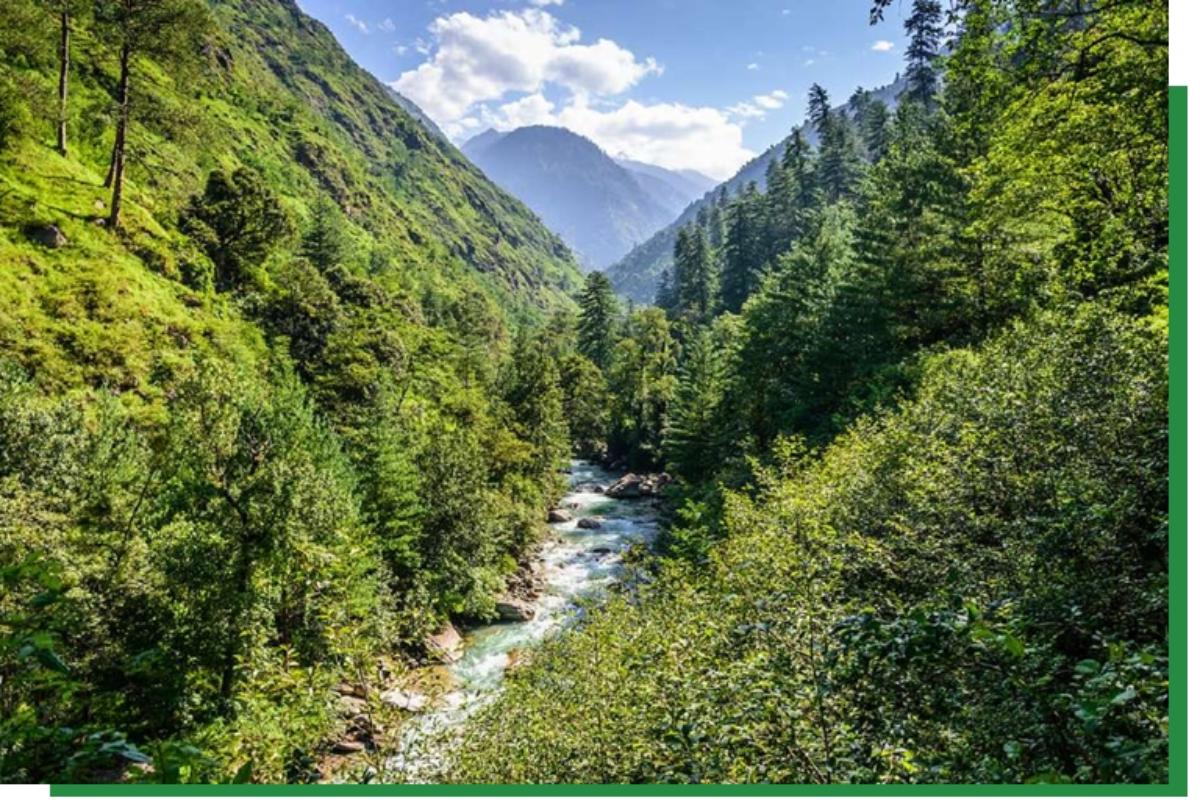
Forests, Actual Forests and Missing Forests
37,948 sq km out of the total geographical area of 55,673 sq km of the state is recorded as forest under various central, state and local laws. In other wards little more than 68% of the total geographical area of the state is recorded as forests. Moreover, nearly one third area of the state is always under snow cover. Details of forests according to their management are given in the following table.
| Forests according to Management | Area (in sq km) |
| Reserved Forests | 1,898 |
| Protected Forests | 33,130 |
| Unclassed Forests | 2,005 |
Source: State Forest Department, H.P.
Himachal has a huge network of national parks and wildlife sanctuaries to manage its forest. The state has 5 national parks, 26 wildlife sanctuaries and 4 conservation reserves. The largest national park of the state is Great Himalayan National Park (905 sq km) and largest wildlife sanctuary located in Lahaul Spiti is Kibber WLS (2220 sq. km.).
While the legally recorded forest of the state is more than 68% of its total geographical area, the actual forest is very less compared to its recorded forest. The latest India State of Forest Report (2021) observes that out of a total 37,033 recorded forest the actual forest is mere 10,644 sq km. The ISFR does not give account of as large as 26,389 sq. km (71%) forest land of the state. According to the ISFR-2021 the total forest cover of the Himachal Pradesh is 15,443 sq km out of which a significant forest area of 4,799 sq km is outside of the recorded forest. This forest outside the recorded forest includes forest owned by individual and private agencies. The forest outside of recorded forest constitutes 31% of the actual forest in the state. Details of the forest cover are given in the following table.
| Forest Status | Area in sq km |
| Total Geographical Area of HP | 55,673 |
| Total Recorded Forest | 37,033 |
| Actual Forest Cover in Recorded Forests | 10,644 |
| Actual Forest cover in Forest outside Recorded Forests | 4,799 |
| Un Accounted Forests (missing forests) | 26,398 |
Source: ISFR, 2021
Himachal Pradesh being a crucial Himalayan state in the Western Himalayan region has no forest cover on its 71% of recorded forest land. It can be understood that a large area is snow covered and not feasible for any vegetation. Yet, a significant area of the recorded forest has no tree cover. Unfortunately, no agency including the state forest department has details of this tree-less forest land.
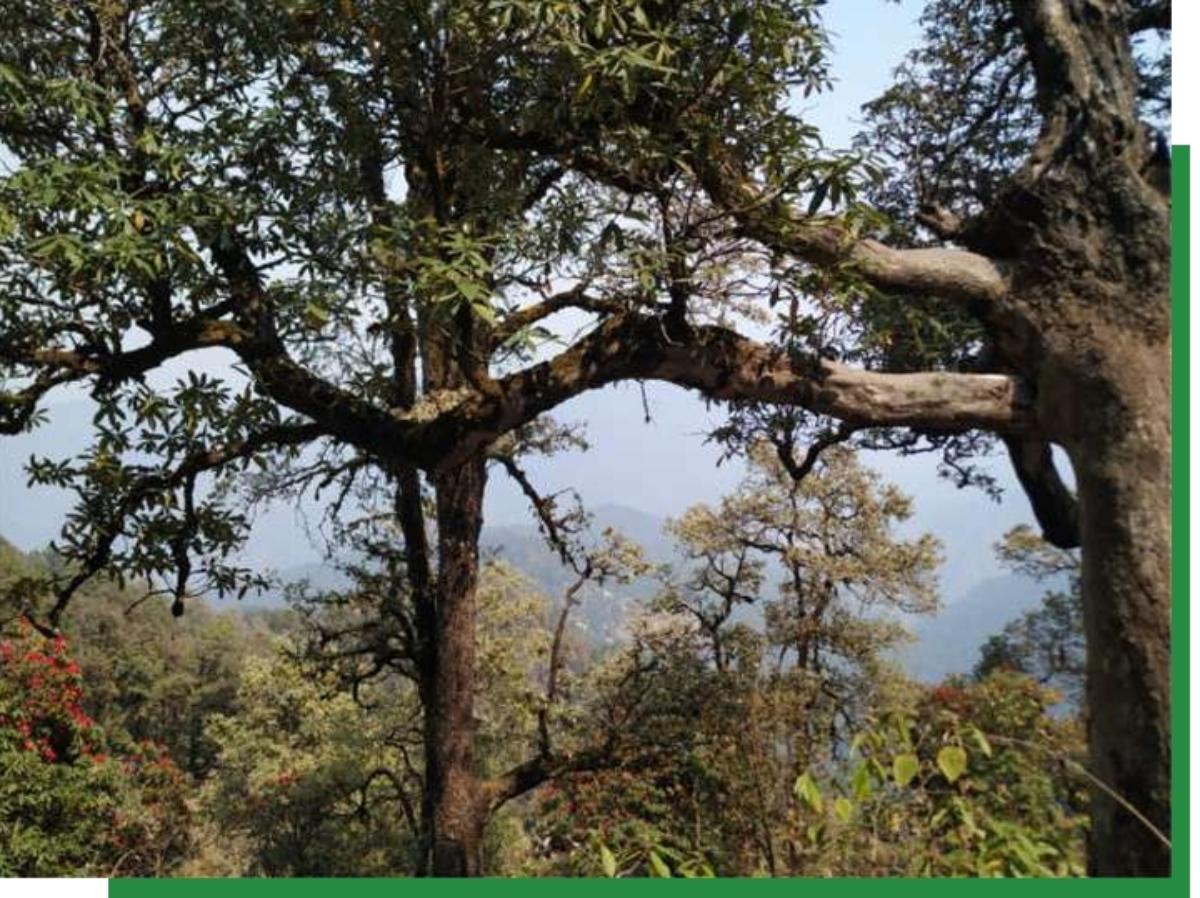
Quality of Forest in HP
| Year | Total Forests | Dense Forest (Canopy Density more than 40%) | Open Forest (Canopy density between 10 to 40%) |
| 1991 | 11,780 | 8,911 | 2,869 |
| 2001 | 14,360 | 10,429 | 3,931 |
| 2011 | 14,679 | 9,605 | 5,074 |
| 2021 | 15,443 | 10,263 | 5,180 |
Compiled from ISFR
Apart from the issue of missing forest, the state is struggling with deterioration of its quality of forests. In the last three decades the total forest cover of the state has increased by 31% from 11,780 sq km to 15,443 sq km. However the increase in dense forest is merely 15% during this period. In fact, the data shows that the dense forest in 2021 has decreased compared to 2001 by 166 sq km. The ISFR data also reveals that from 2011 to 2021 the state lost 61 sq km of dense forest with canopy density more than 70%.
State of Land in Himachal Pradesh:
The geography of Himachal Pradesh is divided into four agro ecological zones and nine sub zones. The Sub Humid Mid Hill agro ecological zone is the smallest and Dry Temperate High Hill zone is the largest agro ecological zone of the state. Soil in low hills and dry temperate high hills are neutral and low to medium in Organic Carbon (OC), Cation Exchange Capacity (CEC) and Water Holding Capacity (WHC). Mid hill soil is moderately acidic and high in OC, CEC and WHC[12]. The variation of agro ecological conditions available in the state diversifies its agricultural practices from production of basic grains such as wheat & rice to apples, kiwis, vegetables and flowers.
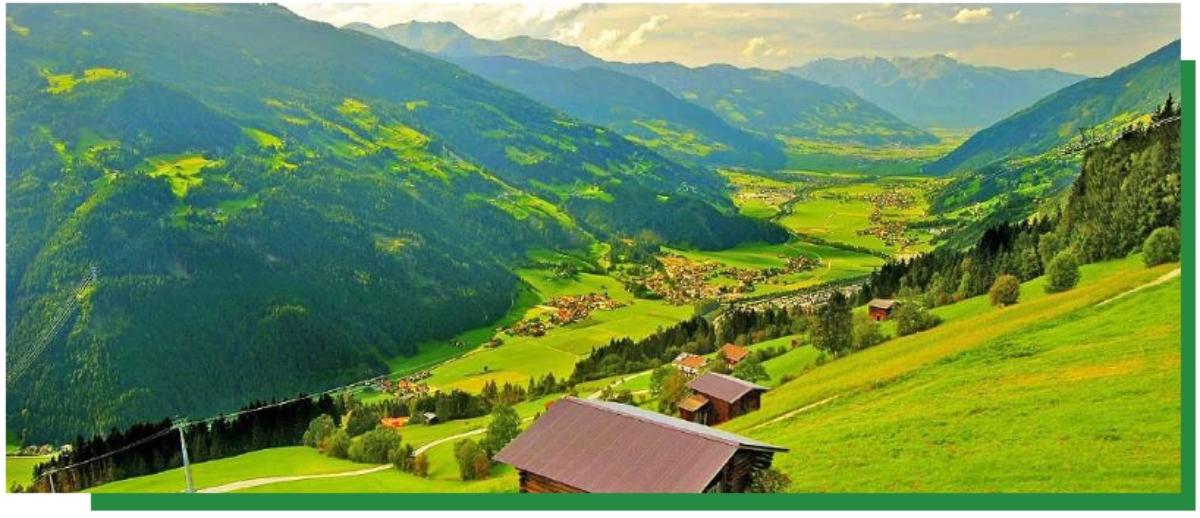
Agro Ecological Zones of Himachal Pradesh
| Agro Ecological Zone | Area (% of Total Area | Soil Type |
| Sub Tropical Sub Montane and Low Hills | 18.5 | Sandy Loams and Loamy Sand |
| Sub Humid Mid Hills | 8.4 | Sand Loam- Clay, Silt Loam-Loam |
| Wet Temperate High Hill | 16.5 | Mainly Loamy Shallow- acidic |
| Dry Temperate High Hill | 56.6 | Sandy Loams Sends and Pebbles |
https://agriculture.hp.gov.in/en/agro-climatic-zone/
Nearly 68 per cent of total geographical area of Himachal Pradesh is recorded as forest land out of which the actual forest cover is 26% of the total area. Nearly one third (32.8%) of the landmass of the state is open and permanent grazing land[13]. The size of agricultural land is about 10 percent of the total geographical area of the state. In the last two decades insignificant changes were observed in the land use pattern of the state.
Classification of Land of Himachal Pradesh (,000 Hectare)
| Year | Land Not available for Cultivation | Other Uncultivated Land Excluding Fallow Land | Total Fallow Land | Net Area Sown | Cropped Area | ||
| Area under Non Agricultural Uses | Barren and Un culturable Land | Total | |||||
| 1998-99 | 238.5 | 909.7 | 1,148.3 | 1,671.1 | 84.5 | 549.4 | 970.1 |
| 2008-09 | 467.8 | 653.9 | 1,121.7 | 1,706.1 | 79.1 | 539.4 | 946.1 |
| 2018-19 | 358.3 | 774.4 | 1,132.8 | 1,692.4 | 83.9 | 542.3 | 914.0 |
While the land use pattern of the state is static, the 10% land that is used for agriculture has observed significant changes in the last three decades. The land which was primarily used for food grains such as Wheat, Maize, Rice and Pulses is gradually moving in horticultural productions such as fruits and vegetables. In this period the sharpest decline was recorded in land area used for production of Wheat, Maize and Pulses. The vegetable production area has doubled from 45 thousand hectares in 2000-01 to 92 hectares in 2021-22.
Area under principal crops in Himachal Pradesh (in thousand hectares)
| Year | Wheat | Maize | Rice | Pulses | Total Food Grains | Fruits | Vegetables |
| 1993-94 | 375 | 305 | 88 | 42 | 855 | 182 | – |
| 2000-01 | 363 | 298 | 82 | 31 | 815 | 217 | 45 |
| 2005-06 | 385 | 295 | 79 | 07 | 777 | 187 | 46 |
| 2010-11 | 357 | 296 | 77 | 34 | 795 | 211 | 65 |
| 2017-18 | 319 | 281 | 72 | 19 | 725 | 231 | 89 |
| 2021-22 | 320 | 263 | 66 | 15 | 711 | 235 | 92 |
Soil Challenges in Himachal Pradesh
Both natural and anthropogenic interventions have contributed to degradation of soil in Himachal Pradesh. The soil in the state is majorly facing two challenges namely soil erosion and loss of natural soil nutrient due to excessive use of fertilizers. These two threats are briefly described in the following section.
Use of Chemical Fertilizers
In the financial year 2021-22, Himachal Pradesh consumed 56,000 tonnes[14] of chemical fertilizers and 454 metric tonnes of chemical pesticides[15]. The consumption of bio fertilizer in the state was just 5 metric tonnes. The table below shows that in the last three decades the per hectare consumption of chemical fertilizer has doubled from 30.08kg/ha in 1993-94 to 64.68 kg/ha in 2020-21. The exponential growth was observed in use of Phosphatic and Potassic chemicals in these three decades.
Fertilizer Consumption per Unit of Gross Cropped Area in HP
| Year | Nitrogenous (N) (kg/ha) | Phosphatic (P) (kg/ha) | Potassic (K) (kg/ha) | Total (NPK) (kg/ha) |
| 1993-94 | 25.79 | 02.55 | 01.74 | 30.08 |
| 1998-99 | 30.4 | 05.38 | 04.33 | 39.75 |
| 2003-04 | 32.35 | 09.11 | 07.53 | 48.5 |
| 2008-09 | 37.48 | 11.31 | 11.84 | 60.63 |
| 2018-19 | 41.04 | 10.69 | 10.06 | 61.79 |
| 2020-21 | 41.20 | 12.28 | 11.20 | 64.68 |
Soil Erosion
Soil erosion is yet another problem Himachal Pradesh is facing due to a number of reasons such as sharp slops, continuous degradation of forests, large non vegetative area, increase in extreme weather conditions such as long dry spells and flash floods. A study carried out in 2014 had estimated that 54% landmass of Himachal Pradesh is prone to soil erosion. Out of this 98% is due to surface runoff[16]. Furthermore, the Land Desertification and Land Degradation Atlas of India reported that as high as 43.11 per cent of the state is under degradation and desertification[17].
State of Climate in Himachal Pradesh
Within the Western Himalayan Region the unique climate of Himachal Pradesh diversifies and distinguishes its landscape and climatic conditions. This uniqueness of the state has been shaping its rich culture, economy and ecology from time immemorial. The change in global temperature and local anthropogenic pressures have adversely affected its climate and thereby increased vulnerability of natural resources of the state.
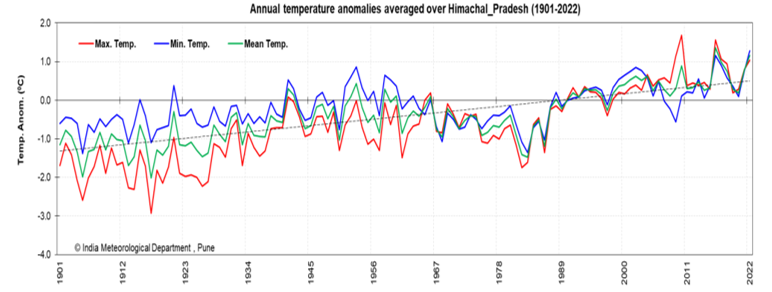
A compilation of temperature over Himachal Pradesh from 1901 to 2022 by IMD reveals that the annual mean temperature during the period significantly increased at the rate of 1.5 degree centigrade per 100 years. The maximum temperature also increased at the rate of 2.18 degree centigrade per 100 years during the period.
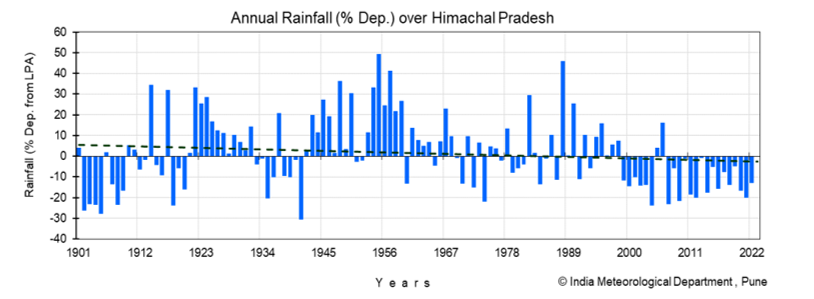
Himachal Pradesh receives its 59% rainfall during south-west Monsoon (June- September) and 19% during winter (Jan-Feb). The IMD data reveals that in both seasons Himachal Pradesh gradually moved from average excess rain in the early 1900s to rain deficient in the last 2-3 decades[18]. Both the rainfall and the temperature of the Himachal Pradesh has significantly changed in the last 100 years and more importantly the rate of change has gradually increased in the last 2-3 decades. This change in climate has further changed the quality and quantity of other natural resources in the state. Some climate led changes in natural resources are explained in the following section.
Impact of Climate Change on Natural Wealth of Himachal Pradesh:
Glaciers
The entire Himalayan mountain range is more vulnerable to global warming compared to other mountain ranges in the world. An assessment of the ICIMOD in 2019 revealed that the temperature of Hindu Kush Himalayas are rising faster compared to the global average[19]. The IPCCC report had also found that the warming has occurred in the Himalayan mountain range that has changed the snowline, glaciers and precipitation in the Hindu Kush Himalayas[20]. Himachal Pradesh is one of the important states in the western Himalayan region that has global responsibility to protect the Himalaya. A recent study by scientists of IIT Hamirpur found that the total glacial area of Himachal Pradesh has decreased from 4020 sq km in 1994 to 2198 sq km in 2021[21]. Apart from snowlines and glaciers the impact of global warming is now visible on other natural resources such as degradation of forests, land and drying of water sources.
Forest Degradation
Successive FSI report on India’s State of Forest Reports reveals that the very dense forests are gradually declining despite the fact that total forest cover is increasing in the state. Moreover, the latest ISFR report of 2021 observes that the entire forest cover of the state will experience an increase in temperature more than 1.5 degree centigrade and more than 20% rain deficient/excess by 2030. If the situation persists the report further estimates that by 2085 the nearly 93% of the state’s forest will experience an increase in temperature by more than 5.1 degree centigrade and more than 38% rainfall departure[22]. These climatic changes are sufficient to completely change the ecosystem and local biodiversity.
Desertification and Land Degradation
Desertification and land degradation is very high in Himachal Pradesh compared to other Himalayan States. According to the Desertification and Land Degradation Atlas 43.11% of the total geographical area of the state is under degradation and desertification. The land under degradation in the state has increased from 38.46% in 2003-05 to 43.11% in 2018-19. Major causes of land degradation in Himachal Pradesh are vegetation degradation (32.27%), Frost Shattering (5.97%) and Water Erosion (4.83%).
[1]T E R I, 2015. Green Growth and Water in Himachal Pradesh. New Delhi: https://www.teriin.org/projects/green/pdf/HP-Water.pdf
[2]HP State Centre for Climate Change, Directory of Water Resources in Himachal Pradesh,https://hpccc.hp.gov.in/SCCC%20Reports/Water%20Sources%20in%20Himachal%20Pradesh.pdf
[3]Himachal Pradesh Development Report, 2002, Department of Planning,http://164.100.161.239/plans/stateplan/sdr_hp/sdr_hpch2.pdf
[4] NITI Aayog, 2017, Inventory and Revival of Springs in Himalayas for Water https://dst.gov.in/sites/default/files/NITI-Aayog-report-Springs-29Dec2017-FINAL.pdf
[5] Ministry of Jal Shakti, 2023, First Water Bodis Census, Vol. 1 https://cdnbbsr.s3waas.gov.in/s3a70dc40477bc2adceef4d2c90f47eb82/uploads/2023/04/2023040672.pdf
[6]CGWB, 2023, Dynamic Groundwater Resources of India, 2023, GoI, https://cgwa-noc.gov.in/LandingPage/LatestUpdate/NCDGWR2023.pdf
[7] Govt. H.P. Human Development Report, 2002, https://planning.hp.gov.in/plg_Reports/HPHDR-02.pdf
[8] TERI, 2015. Green Growth and Water in Himachal Pradesh. New Delhi: The Energy and Resources Institute. 14 pp.https://www.teriin.org/projects/green/pdf/HP-Water.pdf
[9]Sharma et al, 2022, Glacier retreat in Himachal from 1994 to 2021 using deep learning, Remote Sensing Application- Society and Environemnt, Vol. 28 https://www.sciencedirect.com/science/article/abs/pii/S2352938522001781
[10]CBCB, 2022, Polluted River Stretches for Restoration of Water Qualities, GoI, https://cpcb.nic.in/openpdffile.php?id=UmVwb3J0RmlsZXMvMTQ5NF8xNjcxNzc3ODg2X21lZGlhcGhvdG8xODc0Ni5wZGY=
[11]Himachal Pradesh State Forest Department, https://hpforest.gov.in/the-forest-detail-2 (25 Aug 2024)
[12]Himachal Pradesh Biodiversity Board, https://hpbiodiversity.gov.in/Pdf/Soil%20types%20of%20HP.pdf
[13]Himachal Pradesh, 2008, Annual Season and Crop Report – 2007-08, Govt pf Himachal Pradesh, https://himachal.nic.in/WriteReadData/l892s/13_l892s/1695123930.pdf
[14]Ministry of Agriculture and Farmer Welfare, Agricultural Statistics at a Glance, 2022, GoI, https://desagri.gov.in/wp-content/uploads/2023/05/Agricultural-Statistics-at-a-Glance-2022.pdf
[15]Lok Sabha unstarred question no. 1069 answered on 13th December, 2022, https://sansad.in/getFile/loksabhaquestions/annex/1710/AU1069.pdf?source=pqals
[16]Prashanth M, Kumar A, Dhar S, Verma O, Rai SK and Kouser B (2023) Land use/land cover change and its implication on soil erosion in an ecologically sensitive Himachal Himalayan watershed, Northern India. Front. For. Glob. Change 6:1124677. doi: 10.3389/ffgc.2023.1124677, https://www.frontiersin.org/journals/forests-and-global-change/articles/10.3389/ffgc.2023.1124677/full
[17]Space Application Centre, Govt of India, 2021, Desertification and Land Degradation Atlas of India, https://vedas.sac.gov.in/static/atlas/dsm/DLD_Atlas_SAC_2021.pdf
[18] India Meteorological Department, 2022, Statement on Climate for the State of Himachal Pradesh, https://mausam.imd.gov.in/shimla/mcdata/cli_hp.pdf
[19]ICIMOD, 2019, The Hindu Kush Himalaya Assessment, https://doi.org/10.1007/978-3-319-92288-1
[20] International Panel on Climate Change (IPCC) https://www.ipcc.ch/report/ar6/wg1/downloads/factsheets/IPCC_AR6_WGI_Regional_Fact_Sheet_Mountains.pdf
[21]Sharma et al, 2022, Glacier retreat in Himachal from 1994 to 2021 using deep learning, Remote Sensing Application- Society and Environment, Vol. 28, https://www.sciencedirect.com/science/article/abs/pii/S2352938522001781
[22] FSI, 2023, India Sate of Forest Report, Govt of India, https://fsi.nic.in/isfr-2021/chapter-11.pdf

